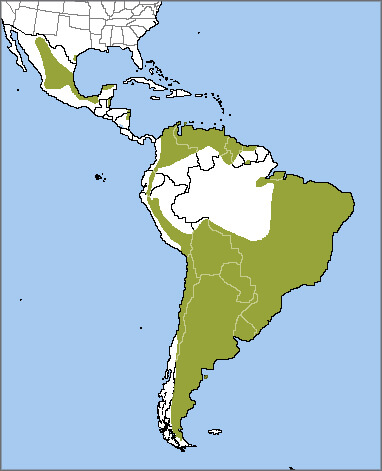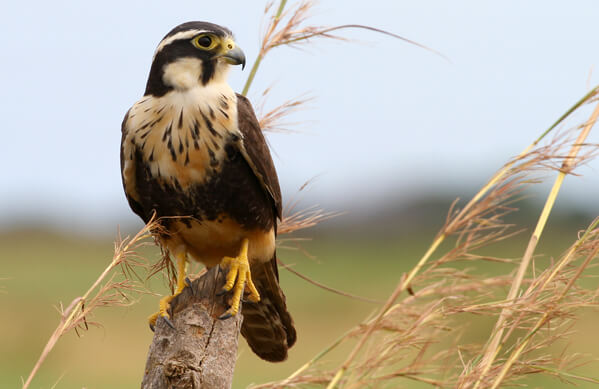
Aplomado Falcon range map by ABC.
The handsome Aplomado Falcon is as attractive as its smaller relative the American Kestrel, but is much harder to find, at least in the U.S. Its name "aplomado” is Spanish for “gray” or “lead-colored,” and refers to the blue-gray plumage of this bird's back. Below, a black belly band separates the Aplomado Falcon's light-colored, sometimes streaky upper breast from its rufous belly. Bold face markings include the dark "mustache" common to most species in the falcon family, set off by a contrasting dark eye stripe and white eyebrow.
Adult Aplomados are slender, with long legs, wings, and tail, proportioned somewhat like an accipiter such as the Cooper's Hawk. In size, this species is just a bit smaller than the Peregrine Falcon. The Aplomado's northern subspecies once ranged throughout Arizona, New Mexico, and Texas, but was largely extirpated from those states and Northern Mexico by the 1950s.
Disappearing Habitats
The Aplomado Falcon once ranged throughout the open grasslands and coastal savannas of southern Texas, New Mexico, and Arizona. However, these favored habitats were lost to encroaching human settlement. By 1900, 80 percent of coastal prairie in Texas had been converted to farms and ranches, with similar losses of native habitat in southern New Mexico and Arizona. Over the years, many areas left to regenerate came back as mesquite brushland, rather than yucca-studded grassland favored by this bird.
Pesticide use (including the once-widespread use of DDT) also decimated Aplomado Falcon populations by causing eggshell thinning and failed nesting attempts. Poisons used in prairie dog eradication efforts across New Mexico and Arizona also impacted falcons' prey availability, and indirectly poisoned these raptors.
A Struggling Subspecies
Three subspecies of Aplomado Falcon are recognized, varying in size and plumage color. The "Northern" subspecies was placed on the U.S. endangered species list in 1986. The other two subspecies remain relatively common in parts of Central America and across much of South America, reaching as far as the southern tip of Argentina.
Aplomado Falcons are permanent residents in most of their range, but some populations make altitudinal migrations, with birds that breed at higher elevations moving to lower elevations for the winter.
The Aplomado Falcon's call is a sharp kek-kek-kek, most often heard when the bird is disturbed or feels threatened.
Listen here:
(Audio: Alvaro Riccetto, XC65742. Accessible at www.xeno-canto.org/65742)
Better Together
Like the Harris's Hawk, the Aplomado Falcon hunts in pairs or family groups, cooperating to chase, flush out, and capture prey. It preys upon birds (particularly pigeons and doves), larger insects such as large moths and beetles, small mammals like rodents and bats, and reptiles such as lizards.
This versatile falcon is equally adept at hunting in the air, where it is a swift and maneuverable flier, and on the ground, where it readily pursues prey on foot. It follows brush fires to pick off prey fleeing the flames, and shadows larger animals and even vehicles to exploit potential prey startled from cover. Similar to another talented aerialist, the Swallow-tailed Kite, the Aplomado Falcon also catches and eats insects while in flight.
This species will also sometimes steal food from other birds, including ravens, herons, jays, and kingfishers, as well as other Aplomados, Merlins, and other falcons.
Faithful Falcon
Courting Aplomado Falcons soar, swoop, and hunt together. They are faithful partners: Mated pairs remain together year-round, and during breeding season, they pass food to each other mid-air during courtship displays, and even feed together from a single catch, with the larger female offering small bits of food to her mate. How “romantic”!
The Aplomado Falcon does not build its own nest; instead, it commandeers the stick nest of another raptor or crow species such as the Red-tailed or Swainson's Hawk, Brown Jay, or Chihuahuan Raven. Aplomado Falcons living in the tropics often choose to nest atop a large bromeliad. They may also nest on cliff ledges.

Aplomado Falcon and nestling. Photo by Danita Delimont, Shutterstock
The female Aplomado Falcon lays two to three eggs, which both male and female take turns incubating. They aggressively defend their nest and young, attacking and driving away intruders and potential predators, including much larger birds such as the Great Horned Owl and Turkey Vulture, and even dogs and people.
Once the chicks hatch, the male falcon supplies food to the female, who tears off small bits to feed them. She continues to feed the young even after they fledge, usually four to five weeks after hatching. The young falcons may remain in their parents' territory for several months.
Fledged Aplomado Falcons spend lots of time playing "tag" in the air, chasing after siblings and larger birds as they perfect flying skills that will help keep them alive. They also pick up, carry, and peck apart sticks — practice for hunting their own food.
Cross-border Conservation Efforts
The Peregrine Fund and other conservation groups began reintroducing the Endangered “Northern” subspecies into parts of its historic North American range in the mid-1980s and early 1990s. Over the years, hundreds have been released. A small breeding population of Aplomado Falcons now exists in southern Texas. The falcon has also been reintroduced in New Mexico but as yet is not successfully breeding in the wild in that state.
ABC is working with partners in the El Tokio and Valles Centrales BirdScapes, both located in the Chihuahuan Desert grasslands of Mexico, to benefit resident birds such as the Worthen's Sparrow and Aplomado Falcon, as well as migratory species that breed on the Great Plains and winter in Mexico, including the Sprague's Pipit, Chestnut-collared Longspur, Mountain Plover, and Long-billed Curlew.
ABC also heads up the Rio Grande Joint Venture, which works in three Bird Conservation Regions that once supported populations of the "Northern" Aplomado Falcon (Chihuahuan Desert, Tamaulipan Brushland, and Gulf Coast Prairie). This binational Joint Venture connects people and organizations across the U.S.-Mexico border to conserve birds and their habitats.
Donate to support ABC's conservation mission!



















































